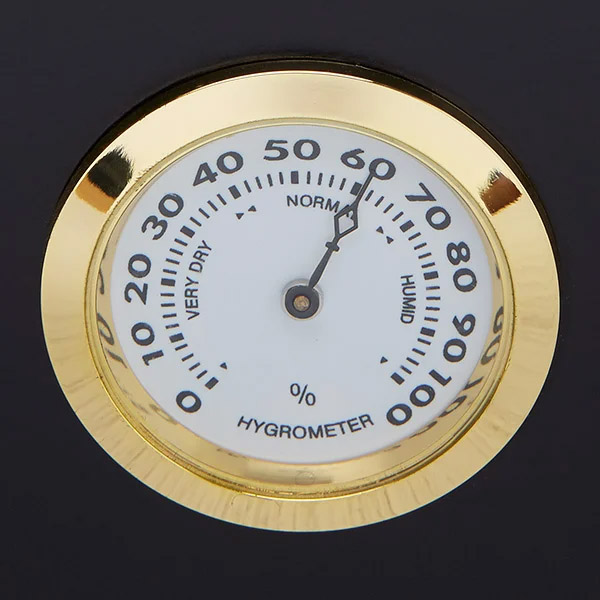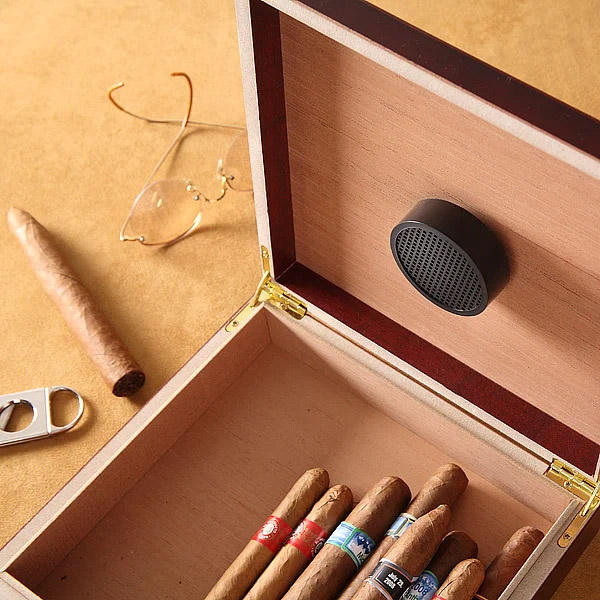What Is a Humidor? | The Expression Leave a comment

Whether you are a budding cigar enthusiast or a true aficionado well versed in the finest aged tobaccos, a humidor is an absolute essential for touring the cigar world. In fact, anyone who plans to wait more than a few days to smoke a cigar purchase is in need of some sort of preservation method. That’s because when a cigar is simply kept in a standard container or out in the open, the tobacco begins to gradually — and irreversibly — dry out, which effectively ruins the entire cigar smoking experience.
Even if stored in a climate-controlled area, a cigar will dry out, as heating and air-conditioning systems affect a room’s moisture level. While the beginner’s trick of storing a smoke inside a plastic bag with a damp paper towel may keep it in reasonable condition for a day or so (careful, doing so may also compromise its aroma), a quality humidor allows cigars to be kept in prime condition for years — yes, years!
So grab your essentials, some genius cigar accessories, and let’s explore the humidor.
What is the history of the humidor?
Humidors trace back to the 19th century as cigar connoisseurs began to seek innovative ways to preserve the quality of their prized smokes. The earliest humidors were simply handmade wooden boxes lined with Spanish cedar, a wood known for its ability to regulate humidity and enhance the flavor of tobacco. An Irish furniture maker named Terence Manning, however, is considered the father of all proper humidors, having constructed a full cabinet humidor in the late 1800s using exotic cedar woods acquired from South America.
Invention of the most popular model, the desktop humidor, is credited to Zino Davidoff, the son of a Swiss tobacco merchant. Davidoff’s early 20th century travels to South America and Cuba (home to the arguably world’s finest cigars) inspired him to create a device that could simulate humidity levels and climate found in the island country. Davidoff is also said to have crafted the first self-regulating humidor as well as the initial model of the walk-in humidors still found in quality cigar shops.
How does a humidor work?
As its name suggests, a humidor is meant to regulate the humidity to which cigars are exposed. However, for a humidor to be a humidor, and not simply a cigar container — like the wooden boxes cigars initially come in — it has to meet certain requirements. First, a high-quality build is necessary to help ensure a steady internal temperature. That means, for instance, it must shield cigars from temperature shifts that may occur when rooms experience changing levels of sunlight, or if a window is left open during an especially cold or hot season.
A humidor also keeps pests away from cigars — and not simply ants or flies carrying germs but actual tobacco beetles. Exposure to even a few of these tiny creatures can be a death sentence for a cigar, as the holes they create when boring through tobacco leaves can leave a cigar un-smokable.
Another living threat to cigars is mold, which may form when cigars are stored in airtight conditions. To prevent this, a proper humidor must allow for gentle airflow, as mold will send any cigar — no matter the value or its rarity — straight to the trash.
What are the parts of a humidor?
Every humidor contains several pieces that work in conjunction to maintain optimal cigar storage conditions. The humidifier introduces moisture into the air at a measured rate, maintaining a crucial 70% to 75% moisture level within the humidor. A hygrometer is a vital gauge that allows the owner to accurately monitor this humidity level, allowing for necessary moisture level adjustments to be made. Lastly, the cedar lining of a humidor, besides providing a classy look, naturally helps both maintain even moisture and deter tobacco beetles.


In addition to blocking bugs, the inherent aromatic qualities of cedar serve to enhance the flavor profile of the cigars stored within it. From the humidor’s earliest incarnations, Spanish cedar has always been the ideal variety for its interior, though American or Canadian red cedar and Honduran mahogany are popular lining woods as well. Most wooden humidors are either constructed entirely of one of the cedars or cherry wood lined with cedar, save for their exterior veneer, which is often customized or engraved.
How do you care for a humidor?
Humidor operation begins by “seasoning” the humidifier component using distilled water — never tap water, as it may spawn mold — or a propylene glycol solution, followed by a 24-to-48-hour wait while the liquid absorbs. (Some specific models also allow for the usage of moisture packets instead.) Once the humidor is seasoned, arrange the cigars inside, though take care to space them properly so as to allow airflow between them. Overcrowding can lead to mold growth as well as uneven moisture levels across the body of a cigar.
Monitor the hygrometer consistently, and repeat the seasoning process as needed to maintain a 65% to 75% humidity level. Additionally, periodically rotate the cigars to ensure all sides age evenly. To prevent mold growth, moisten a soft cloth with distilled water and use it to evenly wipe and dry the humidor’s interior. Store the device itself in a cool, dark place free from sunlight and air drafts. Kept your humidor’s interior temperature at 68 to 70 degrees Fahrenheit to preserve the optimal flavor and quality of your cigars.
What are the different types of humidor?
Cigar humidors come in a variety of shapes, sizes, and designs, ranging from the time-tested wooden devices to high-tech electronic models costing several thousand dollars. Pro-level enthusiasts are known to own multiple humidors, such as a large device for long-term storage kept in a fixed location (the equivalent of a wine cellar) and a compact, easily transported desktop version that holds simply a half-dozen or so smokes. Some top-tier smokers even maintain different humidors for specific brands, as storing multiple varieties of cigar alongside one other may lead to changes in aroma and taste noticeable to a refined cigar smoker’s palate.




